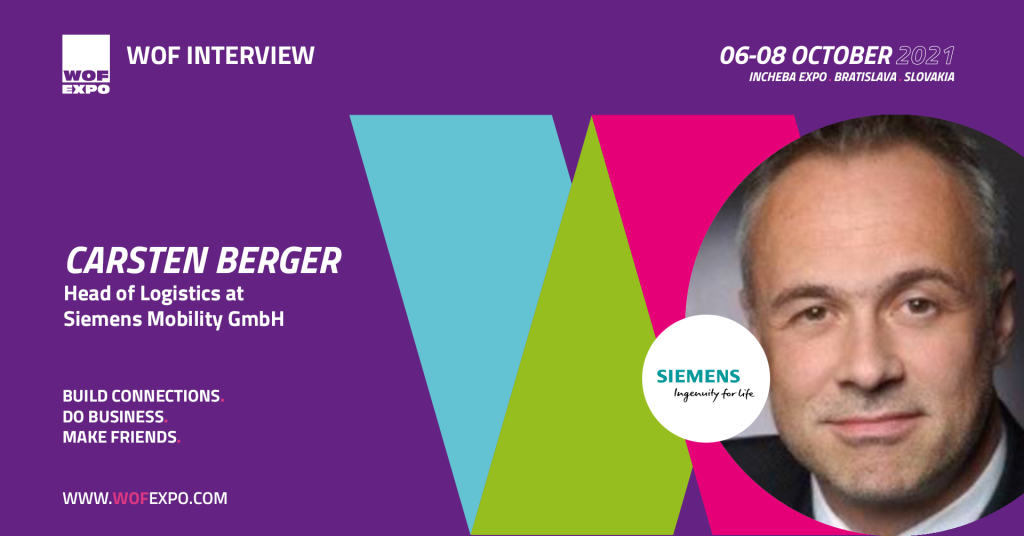Interview with Carsten Berger
| Mr. Carsten Berger is a Head of Logistics at the Siemens Mobility GmbH. After several years of Germany-wide installation and commissioning, 5 years of international work experience as Site Manager with worldwide deployment followed, Mr. Berger took a sidestep into logistics. He started his career in the logistics with the development of a TMS system, the purchase of logistic services especially in the field of packaging as well as terminal services and the management of a cross-divisional Center of Competence. Later on he became the Director to a strategic function at Sector level. Change to the strategic logistics of the Mobility Division, management of the project logistics department in senior director function until taking over the division logistics management. |
1. Decarbonization (CO2 reduction), digitization and decentralization accelerate the launch of a new energy era at a speed beyond expectations. We support the overarching Siemens goal with passion and sustainability: becoming CO2-neutral by 2030. The goal of SMO Logistics is to be CO2-neutral by 2025 considering the lion share of all our categories and we take our partners and stakeholders on bord. Of course, we will take the remaining share into account in further planning. We will also examine and implement additional mitigation and compensation options, e.g. process changes or purchasing of creditable certificates. 2. Did you have to revise your strategies towards more aggressive clean energy targets? First of all, we already have strong commitments to ambitious clean energy and emissions targets. Siemens just committed to: |
- SBTI(Science based-targets initiative); to limit global warming to 1.5. degrees, we commit to a science-based reduction pathway along our entire value chain.
- RE100: We aim for a 100% share of electric vehicles in our fleet by 2030
- EP100: We commit to own and lease only net zero buildings by 2030
- EV100: We commit to source 100% renewable electricity by 2030
| One of the first questions we asked ourselves: Can CO2 neutrality entail additional costs? After all, the overall target of sustainability is the simultaneous and equally important implementation of environmental, economic and social targets. Of course, we are striving to avoid additional costs or to achieve short amortization periods, but in the first step, the end certainly justifies the means. Will our customers support this approach? Certainly, for example, because reducing transports and implementing innovative concepts will enable cost reductions. On our side and on the side of service providers, and finally also at the customer. To what extent can digitalization make a contribution here? Here, too, the motto is “dive deeper”, and our digitization team is ideally positioned to do so. I will get back to this later. 3. What kind of innovations do you develop to accelerate the pace of the global energy transition? That is manifold. I am happy to present some of the other highlights that I am aiming for and that are currently being implemented: |
- Introduction of CO2 reporting at both Siemens Mobility and the corporate level / rates vs. CO2 emissions
- Setting up SCFs (Supplier Comparison Factor) for CO2-reduced transports / suppliers who “pioneer”
- Globalization vs. Localization vs. Global Value Sourcing
- Deceleration of transport chains (engineering, supplier, warehouse service provider, plant, etc.)
- Optimized control of transports, e.g. reducing the number of empty runs: we assume that this saves up to 30% of CO2 at 100% capacity utilization (Ground/truck transport)
- Focus on increased use of rail transport
- Implementation of lighthouse projects, review for success and roll-out, e.g. switching to e-trucks for round trips in urban areas
- Promotion and demand of topics beyond the daily business: What compensation possibilities are there, apart from reforestation and the acquisition of certificates?
- Positive feedback from our suppliers gives us additional tailwind. Quote: “Siemens Mobility, one of the first industrial companies to proactively focus on and “address” this issue“.
4. How do you stay competitive and able to respond to the growing mobility needs of people and goods? Insights from Siemens Mobility GmbH: “Siemens Mobility” explores new ideas, cutting-edge technology and digital innovations that will transform the way we move. |
- We drive innovation in alternative propulsion technologies, e.g. battery-electric or hydrogen powered trains for non-electrified rail tracks.
- We digitalize rail infrastructure to increase capacity and improve energy efficiency and carbon emissions at the same time.
- We increase life-cycle of our customers assets through predictive maintenance and increased availability of trains drives down operational costs and helps to convince passengers to move to rail from other modes of transport.
- We provide choices to passengers to travel from door to door in the most efficient, seamless and climate friendly way possible, through our offerings of integrated mobility solutions enabled via MaaS (mobility as a service).
| We pursue this corporate goal in SCM management with pioneering spirit and at full speed – both in inbound and outbound. 5. What do you think of the European Green Deal initiative? We must all strive for a common goal here: becoming the first climate-neutral continent – after all, we only have one earth and “Another Earth” is Hollywood stuff for good blockbusters. The mobility sector is able to, and will, make a major contribution, in the way already explained, towards creating a modern, resource-efficient and competitive economy – let’s do it. |
 | Siemens Mobility is a technology company focused on industry, infrastructure, mobility, and healthcare. Creating technologies for more resource-efficient factories and resilient supply chains to smarter buildings and grids, to cleaner, comfortable transportation and advanced healthcare, the company empowers customers to transform the industries that form the backbone of economies, transforming the everyday for billions of people.
www.mobility.siemens |

